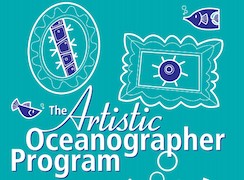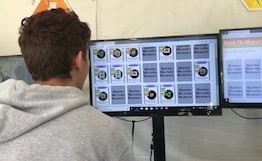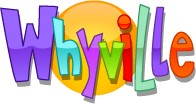
Artistic Oceanographer
A hands-on activity for children that pairs science with art. The Artistic Oceanographer program engages elementary-age students in learning about different kinds of marine phytoplankton and their strategies for surviving in the ocean. Participants are given the opportunity to view different types of phytoplankton (and maybe even some zooplankton!) with a microscope and on a video screen. Students then design and draw their own fantastical phytoplankton, keeping in mind the survival strategies used by real phytoplankton. This program encourages ocean literacy through multidisciplinary learning.
Whyville
A simulation based virtual world (whyville.net) for preteens and children, and its users (or “citizens”) engage in simulated “real-world” activities sponsored by a wide range of governmental, non-profit, and corporate entities.
Features developed by the Dyhrman lab group include:
- Harmful algal bloom activity
- Microbe War - a microbe game and card collection
- Project Tricho - categorize data from a video plankton recorder to track Trichodesmium abundances

Ocean Science Literacy
Ocean literacy is defined by the Ocean Literacy Network as an understanding of the ocean’s influence on you and your influence on the ocean. An ocean-literate person:
- understands the essential principles and fundamental concepts;
- can communicate about the ocean in a meaningful way; and
- is able to make informed and responsible decisions regarding the ocean and its resources.
The Dyhrman group has been actively championing ocean science literacy for more than 20 years through a suite of efforts and initiatives. These include:
- Open House at Lamont - Open House is a long-standing Lamont tradition, and one that the Dyhrman Group has participated in every year since 2013. The event is an opportunity for our group to showcase our science to the public and to offer engaging, hands-on activities for participants of all ages to help highlight aspects of our work and champion many principles of ocean literacy that drive it.
- MARINE K-12 (Mapping Attitudes and Resources in Ocean Science Education) Study - Despite its universal appeal, ocean science is not prioritized in K-12 education. The Dyhrman group is working with education researchers within C-CoMP on a ground-breaking ocean literacy landscape study to query nearly 2000 middle and high-school teachers on the extrinsic and intrinsic forces that influence teachers' ability and desire to teach ocean science concepts. This is the first large-scale, nationally representative study to explore barriers to covering ocean science in schools.
Hands-On Science Kits
This kit explores plankton and their global importance through four lessons and an optional extension activity. Plankton are tiny plants (phytoplankton) and animals (zooplankton) that are incapable of swimming against major currents in the ocean. In Lesson 1, students learn about plankton through a narrated PowerPoint presentation and investigate and identify various phytoplankton. In Lesson 2, students design their own phytoplankton. In Lesson 3, students investigate zooplankton with a microscope. In Lesson 4, students use an educational CD and virtual microscope to explore phytoplankton, learn about environmental factors that affect phytoplankton growth and distribution, and run a computer simulation to generate phytoplankton blooms. Lessons 1, 2, and 3 are suitable for Grades 3–12, whereas Lesson 4 is geared toward Grades 6–12. Computers (not provided) are required for Lesson 4, and the students (or the teacher) must provide the supplies for the optional extension activity. Pre- and post- surveys are included. Each lesson will require approximately an hour.
This kit was designed to facilitate marine science and oceanographic outreach at all levels. These easy-to-implement activities have been selected as “big hits” with kids of all ages. Explore various hands-on activities with “The Penny Plop” to teach density, shrink and over-inflate a marshmallow to learn about air and ocean pressure, or learn about ocean acidification with the "Breath and Bubbles" experiment. These and other fun activities are all part of the Outreach Kit.
This three-lesson kit familiarizes students with the causes and consequences of ocean acidification: the process by which our ocean is becoming increasingly acidic. Briefly, ocean acidification is caused by increasing atmospheric concentrations of CO2, some of which dissolves in the ocean and forms an acid. An acidic ocean poses threats to marine ecosystems, such as coral reefs. Ocean acidification is one of the most serious environmental issues facing the planet and is predicted to have devastating impacts within the next century.
Lesson 1 includes a simple hands-on experiment, a short PowerPoint, and optional readings with worksheets. In Lesson 2, students conduct a more in-depth experiment with electronic probes to simulate the process of ocean acidification. In Lesson 3, students can use art to engineer adaptations for organisms that are particularly susceptible to an increasingly acidic ocean. A pre- and post- survey is included. Each lesson will require approximately an hour.
Reserve a Kit
These self-contained kits offer lesson plans and materials for hands-on science activities related to oceanography. Kits are:
• Designed for a range of grade levels.
• Easy to use!
• Fully equipped with lesson plans and all supplies.
• Free*!
To reserve a kit, click here. *Shipping not included. Kits are usually picked up/dropped off at LDEO or Teacher’s College in NYC.


